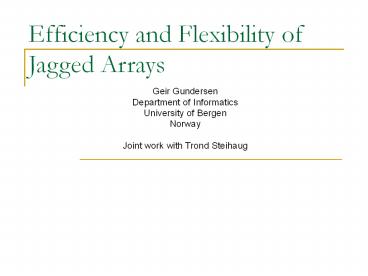Efficiency and Flexibility of Jagged Arrays - PowerPoint PPT Presentation
Title:
Efficiency and Flexibility of Jagged Arrays
Description:
LU decomposition with row partial pivoting (LU=PA) on VBS does not guarantee ... An LU decomposition of a sparse matrix consist of a symbolic and a numerical phase. ... – PowerPoint PPT presentation
Number of Views:266
Avg rating:3.0/5.0
Title: Efficiency and Flexibility of Jagged Arrays
1
Efficiency and Flexibility of Jagged Arrays
- Geir Gundersen
- Department of Informatics
- University of Bergen
- Norway
- Joint work with Trond Steihaug
2
Objectives
- Efficiency of linear and jagged arrays for
several numerical linear algebra algorithms. - Flexibility of linear and jagged arrays for LU
factorization on a banded matrix. - Jagged versus Multidimensional arrays on
row-oriented algorithms in C. - Compare these algorithms on only two platforms
using the languages C, C and Java.
3
Basic Storage Schemes for Matrices
- Storage Schemes
- Multidimensional Arrays
- Jagged Arrays
- Linear Arrays
4
Algorithms
- Algorithms
- Matrix Vector product
- LU Decomposition (LUPA)
- 3D Element Sum/Voxel Sum
5
ANSI C on Red Hat Linux
- Matrix Vector product No indication that using
a linear array is significantly more efficient
than jagged array. - LU decomposition Using jagged array was more
efficient than linear array for all of the input
sizes.
6
Java on Red Hat Linux
- Matrix Vector product No indication that using
a linear array is significantly more efficient
than jagged array. - LU decomposition Using jagged array was more
efficient than linear array for most input sizes.
7
Java on Windows XP
- Matrix Vector product No indication that using
a linear array is significantly more efficient
than jagged array. - LU decomposition Using jagged array was more
efficient than linear array for most input sizes.
8
C on Windows XP
- Matrix Vector product Linear, jagged and
multidimensional arrays have approximately the
same efficiency. - LU decomposition Using jagged and linear
arrays was clearly more efficient than
multidimensional arrays.
9
Jagged versus Multidimensional arrays in
row-oriented algorithms in C
- Jagged arrays are for row-oriented algorithms
approximately 25 more efficient than
multidimensional arrays. - Minor limitations in the current JIT compiler
regarding the elimination of array bounds check
for multidimensional arrays. - Column, diagonally or random traversel with
jagged arrays performs poorly compared to
multidimensional arrays.
10
3D Element Sum Results
11
Utilizing flexibility Sparse Matrices
- A sparse matrix is usually defined as a matrix
where "many" of its elements are equal to zero. - We benefit both in time and space by working
only on the nonzero data structure. - Sparse Matrices have a wide variety of
structures that defines several different data
structures. Some examples
12
Data Structure Jagged Variable Band Storage
- All matrix elements from the first nonzero to
the last nonzero in each row are explicitly
stored. - We only store and work on the nonzero structure
of the banded matrix. - We refer to this data structure as Jagged
Variable Band Storage (JVBS), since we use jagged
arrays to store the matrix. - The last index is given as the sum of the first
index and the length of the array row.
13
LU Decomposition on Variable Band Storage (VBS)
- LU decomposition with row partial pivoting
(LUPA) on VBS does not guarantee that the
nonzero structure is preserved, i.e. we can get
new entries (fill-ins) in the data structure. - An LU decomposition of a sparse matrix consist
of a symbolic and a numerical phase. - In general, no symbolic phase can predict
fill-ins in since the pivot choices are based on
numerical values, during the decomposition.
14
Fill-Ins Issues
- Two approaches
- Resize the whole data structure for each row
that has new fill-ins. - Resize each row that has new fill-ins.
- The first approach must be done using linear or
multidimensional arrays. - The second approach is clearly the most
efficient using jagged arrays. - We do not have any overall loss using jagged
arrays. It is therefore the preferred choice
rather than linear and multidimensional arrays.
15
Java versus C on Red Hat Linux
- Matrix Vector product Java was more efficient
than C on for large m. - LU decomposition C was approximately 10 more
efficient than Java. - C does not outperform Java on any algorithms we
have tested.
16
Not Covered
- Jagged arrays have poor performance on
column-oriented algorithms. - In G. Gundersen and T. Steihaug. Data
Structures in Java for Matrix Computation.
Concurrency and Computation Practice and
Experience Volume 16, Issue 8, Pages 735-815
(July 2004). it is shown for several matrix
multiplication algorithms the impact of
column-oriented algorithms for jagged arrays in
Java. - It is clear from those numerical results that
column-oriented algorithms can be multiple times
slower than their row-oriented versions. - That Java also is as fast as C for some
algorithms is reported in Performance test shows
Java as fast as C, Carmine Mangione, in
JavaWorld, February 1998.
17
Concluding Remarks
- The numerical testing shows insignificant
differences in performance (less than 10)
between Java versus C and Java versus C. - Jagged arrays on row-oriented algorithms in C,
Java and C are competitive with linear arrays,
despite non-contiguously memory layout. - Our observations on the performance of
row-oriented algorithms using jagged arrays are
important and indicate that flexibility and
efficiency are not mutually exclusive.































